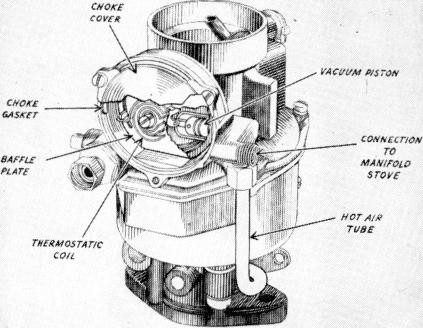The pump plunger head has been designed to eliminate fuel percolation in the pump system. This has been accomplished by the unique design of a ball check and seat in the plunger head. When the engine is not operating, any build up of fuel vapors in the pump well rise and by-pass the ball. This allows the hot fuel and vapors to circulate up the passage in the plunger head and return to the float bowl. Without this feature, any vapor pressure built up would evacuate the fuel in the pump system into the engine manifold, causing poor initial acceleration due to lack of fuel in the pump system as well as difficult hot weather starting.
As a consequence, the choke valve assumes a position where the torque of the thermostatic coil is balanced against the vacuum pull upon the choke piston and air velocity against the offset choke valve, thereby causing a regulated air flow into the carburetor which provides a proper mixture during the warm-up period.
During warm-up, the choke piston serves to modify the choking action to compensate for varying engine loads or acceleration. Any acceleration or increased road load decreases the vacuum exerted on the choke piston. This allows the thermostatic coil torque to momentarily increase choke valve closure to provide the engine with a sufficiently richer mixture for acceleration.
As the engine warms up, hot air from the exhaust manifold "stove" is drawn into the thermostatic coil cover by the vacuum behind the choke piston. This hot air causes a rise in temperature which causes the coil to slowly relax its tension. Thus the choke valve is allowed to move gradually to the full open position.
Figure 7. Choke System
CHOKE SYSTEM
To insure proper starting and driving during cold weather operation, the Model "BC" Carburetor employs a fully automatic choke. (As shown in Figure 7.) This choke system is composed of a thermostatic coil, choke piston, choke valve and fast idle cam and linkage. It is controlled by a combination of intake manifold vacuum, the offset choke valve, atmospheric temperature, and exhaust manifold heat.
The thermostatic coil, which is linked to the choke valve shaft, holds the choke valve closed when the engine is cold. As the engine is started, air velocity against the offset choke valve causes the valve to open slightly against the torque of the thermostatic coil. In addition, as the engine starts, intake manifold vacuum is applied to the choke piston. which also tends to pull the choke valve open.
